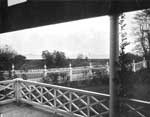
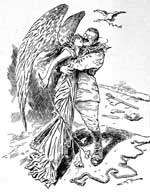
President Roosevelt's back channel efforts, both before and during the negotiations, were crucial in making peace possible. Harper's Weekly. View larger image.
Peace, Part Two - August 30, Wednesday: Roosevelt Thrilled
On the 30th, telegrams of congratulations from around the world were sent to the Japanese and Russian governments and by all parties to Roosevelt. The president, of course, was thrilled that the parties had reached agreement. He was said to have exclaimed that the peace was good for the Japanese, good for the Russians, and “mighty good for me too!” His belief was accurate: Roosevelt received the 1906 Nobel Peace Prize for his diplomatic efforts.
Roosevelt had set up the conference in a neutral hospitable setting without any other nation at the negotiation table in keeping with both the delegations’ request. When the negotiations faltered, he effectively used his back channel diplomacy to gain concessions from both parties that kept the negotiations going until the parties saw a compromise was more reasonable than continuing the war. Everyone knew he deserved the Nobel Peace Prize.
During Wednesday, the Japanese consulted with their government on an armistice protocol and drafted a proposal for informal negotiations the next day with the Russians at the Wentworth.
Witte received the Manchester Municipal Council and others from Amoskeag Mills at the hotel and then met with young summer girls eager to meet the great diplomat. That night Witte invited Portsmouth postmaster John H. Bartlett to dinner in return for Bartlett’s hospitality by inviting the Russians to the minstrel show. A law partner and son-in-law of Calvin Page and later elected governor, Bartlett was also postmaster although at this time he was on leave as a member of Gov. McLane’s staff. Mrs. Peirce hosted the Japanese secretaries at Niles Cottage.
August 31, Thursday: Informal Wentworth Negotiations; Green Acre Visit
The delegations exchanged different drafts of an Armistice protocol in informal meetings in their rooms in the Wentworth. On Thursday, Takahira and some of the Japanese attended a peace meeting at Green Acre, the Bahá’í center in Eliot, Maine. In one of the many speeches given, Takahira praised his country for making peace the instant Japan accomplished the war aims deemed necessary for the country’s national existence. Other Japanese praised Roosevelt’s efforts in the peace process. Green Acre founder Sarah Farmer had committed the institution to the principles of peace and religious unity in 1894. She even had the first known peace flag in the world raised on the hills of Green Acre. A planned meeting for the Russians there was called off later because it would have conflicted with the actual signing of the treaty.
Dr. and Mrs. Arthur C. Heffenger hosted the Russian delegation at their home on Austin Street on Thursday evening. Also attending were many of the local social hosts and Navy officers. Witte remained at the Wentworth to hear a piano recital given by M. Hansen, first secretary of the Russian legation.
Gov. McLane, wanting to appease his North Country supporters who had lost out as treaty hosts, invited members of both delegations to tour the White Mountains, but after the treaty was signed neither side was interested in a social trip.
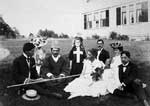
Sarah Farmer, seated at center holding a peace flag, with Japanese visitors and other Bahá’ís. Portsmouth Athenaeum collection. View larger image.
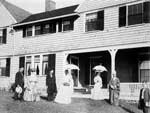
Sarah Farmer, center, at Green Acre Bahá’í School Conference Center. Portsmouth Athenaeum collection. View larger image.
September 1, Friday: Armistice Signed at Wentworth; Niles Cottage Social Event
The armistice protocol was signed in Komura’s suite at the Wentworth at 11:30 a.m., but the protocol indicated that the hostilities would end only when the peace treaty was actually signed. The delegates planned to complete the treaty on September 4 or 5. That evening, from 8:30 - 10:00 p.m., Komura met with Witte and other delegates in Witte’s chambers at the Wentworth in the second informal meeting to continue negotiations on the conditions of withdrawal of troops and cession of the southern half of Sakhalin.
While Witte would have been satisfied with a more general document, Komura relentlessly negotiated all of the fine points necessary to resolve all the questions of peace and disengagement. Legal experts from each country were now given the responsibility of the drafting of the Treaty. American Henry Denison of Lancaster, New Hampshire, a legal and financial advisor to the Japanese Department of Foreign Affairs, represented that country while the Russians were represented by Professor Theodore de Martens, a member of the Council to the Minister of Foreign Affairs.
That evening some of the Japanese were again invited to the Niles Cottage by the Peirces.
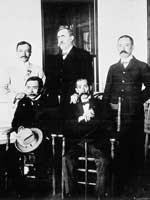
Henry Denison, standing at center, behind Komura and Takahira. Portsmouth Athenaeum collection. View larger image.
September 2, Saturday: Treaty Articles Completed; Rockingham Ball
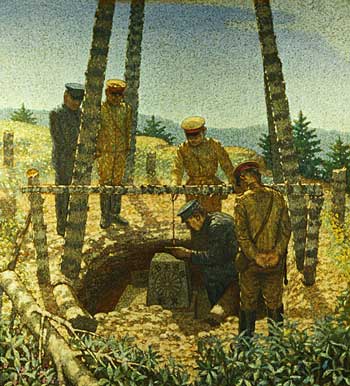
Russian and Japanese soldiers fixing the Sakhalin boundary based on the treaty negotiations. Courtesy of The Memorial Picture Gallery at the Meiji Jingu Shrine. View larger image.
During the afternoon and evening, the delegates continued to negotiate the terms of the treaty articles for the withdrawal of both armies from Manchuria and the cession of Sakhalin in the third and fourth informal meetings held in Komura’s and Witte’s Wentworth suites. The fourth and last informal meeting between Witte and Komura started in Witte’s suite at 9:00 p.m. When it successfully concluded, the parties hoped to get treaty drafts by September 4th or as soon as the papers could be prepared.
Some of the Japanese attended a Mechanic’s Ball at the Rockingham Hotel.
September 3, Sunday: Creek Farm and Wentworth Event
On Sunday, Mrs. Carey and other local hosts again invited the delegates to lunch at Creek Farm. That evening John H. Bartlett and other local hosts dined with Japanese delegates at the Wentworth.
By Monday telegrams and press reports from both Russia and Japan indicated dissatisfaction with the treaty in both countries. The delegates worked feverishly to complete the treaty as if they were afraid difficulties might arise. The Russian delegation’s consternation was caused in part by a Petersburg wire to Witte saying, “Not to hurry with the signing.” In Japan there was news of public protests against the treaty, and the next day petitions opposing the peace treaty were presented to the Emperor.
September 4, Monday: Signing Postponed; Wentworth Love Fest
Witte received Father Hotovitsky of the New York Russian Orthodox Church and a deacon and seven Russian priests from different towns. A peace service was arranged for the next day at Christ Church.
Deputations of newsmen approached the Russians and Japanese to request to be admitted to the treaty signing the next day. They were refused. Both delegations felt the signing was not a “show,” but a “most important state function.”


